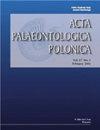来自德国白垩纪的第一批蛛形纲和蛛形纲哺乳动物
IF 1.9
3区 地球科学
Q2 PALEONTOLOGY
引用次数: 4
摘要
德国西北部Balve地区Barremian-Aptian地区新发现的空间类“symmetrodontan”Cifellitherium suderlandicum gen. et sp. 11 .是中欧首次记录的空间类。新的分类群是基于一个下磨牙和两个上磨牙。Cifellitherium与Spalacotherium相似,但不同之处在于在上磨牙上有较小的茎柱和较大的旁柱,在下磨牙上有唇裂的齿环。新研制的Minutolestes潜水磨牙(Minutolestes潜水磨牙gen. et sp. 11 .)是基于一个小尺寸的下磨牙和两个小尺寸的上磨牙。系统发育分析表明,它是由老石门、克雷布索门、干石门和吉马罗托门组成的分支的姐妹分类单元。磨牙根不均匀,牙齿磨损严重的干燥的下颌骨不能归为Minutolestes潜水者gen. et sp. 11 .,因为它们的磨牙是前者的两倍大。该下颌骨归属于一个新的生物分类群Beckumia sinemeckelia gen. et sp. nov.,其牙型为3i、1c、4p、8m,并具有完全缩小的梅克尔沟。下颌骨没有任何冠状骨或脾状骨的痕迹。在系统发育分析中,它似乎是由Achyrodon, Phascolestes, Crusafontia和Hercynodon组成的分支的姐妹分类单元。这些新发现的哺乳动物是其分支在地层学上最年轻的欧洲代表。Beckumia sinemeckelia gen. et sp. 11 .和Minutolestes subsus gen. et sp. 11 . 11 .的晚期生存可能是早白垩世岛屿环境中孤立进化的结果。这一来自中欧的新的洞穴类和洞穴类哺乳动物的发现增加了一种新兴的古生物地理格局,即在巴雷米亚-阿普提亚时期,欧洲在哺乳动物动物群的组成上与亚洲不同。本文章由计算机程序翻译,如有差异,请以英文原文为准。
First spalacotheriid and dryolestid mammals from the Cretaceous of Germany
The new spalacotheriid “symmetrodontan” Cifellitherium suderlandicum gen. et sp. nov. from the Barremian–Aptian of the Balve locality in northwestern Germany is the first record of spalacotheriids in Central Europe. The new taxon is based on one lower and two upper molars. Cifellitherium is similar to Spalacotherium, but differs by smaller stylocone and larger paraststyle on the upper molars, and a labially interrupted cingulid on the lower molar. The new dryolestid Minutolestes submersus gen. et sp. nov. is based on one lower and two upper molars of small size. Phylogenetic analysis revealed it as sister taxon of the clade comprising Laolestes, Krebsotherium, Dryolestes, and Guimarotodus. A dryolestid mandible with unevenly rooted molars and extremely worn down teeth cannot be attributed to Minutolestes submersus gen. et sp. nov. due to possessing molars twice as large in size. The mandible is assigned to a new dryolestid taxon, Beckumia sinemeckelia gen. et sp. nov., and has the dental formula 3i, 1c, 4p, 8m and a fully reduced Meckel’s groove. The mandible lacks any trace of a coronoid or splenial. In the phylogenetic analysis, it appears as sister taxon of a clade comprising Achyrodon, Phascolestes, Crusafontia, and Hercynodon. The new mammals are the stratigraphically youngest European representatives of their clades. The late survival of Beckumia sinemeckelia gen. et sp. nov. and Minutolestes submersus gen. et sp. nov. is possibly the result of isolated evolution in an Early Cretaceous island environment. This finding of new spalacotheriid and dryolestid mammals from Central Europe adds to an emerging paleobiogeographic pattern that Europe was distinct from Asia in the constituents of mammalian faunas during the Barremian–Aptian.
求助全文
通过发布文献求助,成功后即可免费获取论文全文。
去求助
来源期刊

Acta Palaeontologica Polonica
地学-古生物学
CiteScore
2.80
自引率
5.60%
发文量
36
审稿时长
12.5 months
期刊介绍:
Acta Palaeontologica Polonica is an international quarterly journal publishing papers of general interest from all areas of paleontology. Since its founding by Roman Kozłowski in 1956, various currents of modern paleontology have been represented in the contents of the journal, especially those rooted in biologically oriented paleontology, an area he helped establish.
In-depth studies of all kinds of fossils, of the mode of life of ancient organisms and structure of their skeletons are welcome, as those offering stratigraphically ordered evidence of evolution. Work on vertebrates and applications of fossil evidence to developmental studies, both ontogeny and astogeny of clonal organisms, have a long tradition in our journal. Evolution of the biosphere and its ecosystems, as inferred from geochemical evidence, has also been the focus of studies published in the journal.
 求助内容:
求助内容: 应助结果提醒方式:
应助结果提醒方式:


